


Find Ideas
Find ideas to leverage the latest use of technology for your online marketing campaign.
Set Goals
Dream and plan ahead where you want to be and what works in your industry.
Ask for Help
Get personalized consultation on the best practices and approach for your business.


Looking for fresh ideas and proven tactics in interactive marketing? Explore our extensive collection of real-world case studies, innovative examples, and expert insights. Discover how leading brands are engaging audiences and driving results through interactive campaigns. Start transforming your marketing approach today!






A Jeopardy-style campaign that combined knowledge quizzes with rewards in the form of crypto prizes. The campaign was a great success, with 246k unique players and a 95% game completion rate.

Coca-Cola has long been known for its innovative marketing campaigns. But recently, the brand took its marketing strategy one step further by leveraging gamification!

The objective was to create an interactive and enjoyable experience that would not only capture the attention of existing followers but also attract new audiences to the EFA’s content and initiatives.
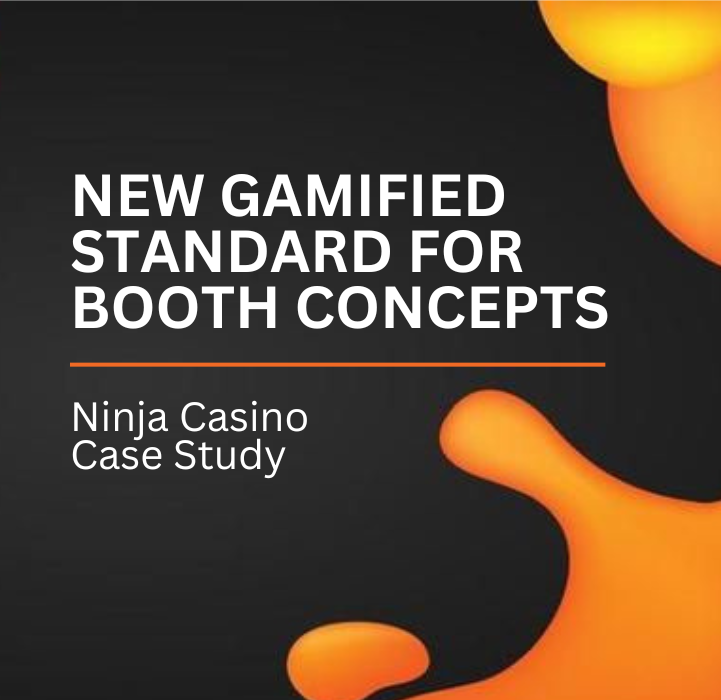
Ninja Casino’s gamified booth concept revolutionized event marketing, captivating attendees and elevating brand recognition at We Love the 90s festival. Witness the results as the Bubble Shooter game engaged festival-goers and left a lasting impact on the event’s success.
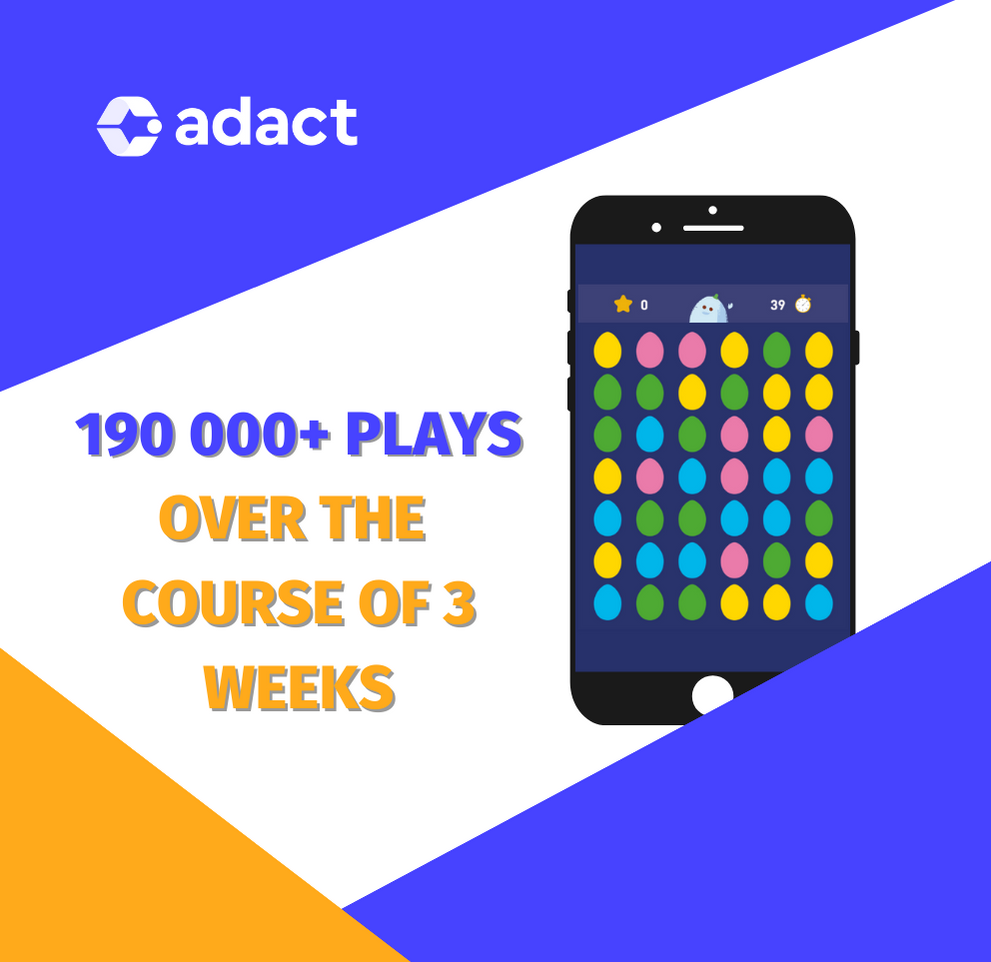
Just recently an egg producer in Estonia called Eggo launched a gamification marketing campaign that achieved mind-blowing results. When they shared the results with us even we, the experienced gamification wizards didn’t believe these results. Nevertheless, they were very true.

The public sector can bring great examples of inevitable struggles within one industry. Recognizing these hurdles, the Federation of Estonian Student Unions (EÜL) chose a creative approach: interactive marketing. This is their story.

Danija, a shoe retailer in the Baltic market, wanted to change how they marketed their products. They needed more people to sign up for their emails and buy more shoes. So, they tried something new: using games in their marketing, like the Wheel of Fortune.
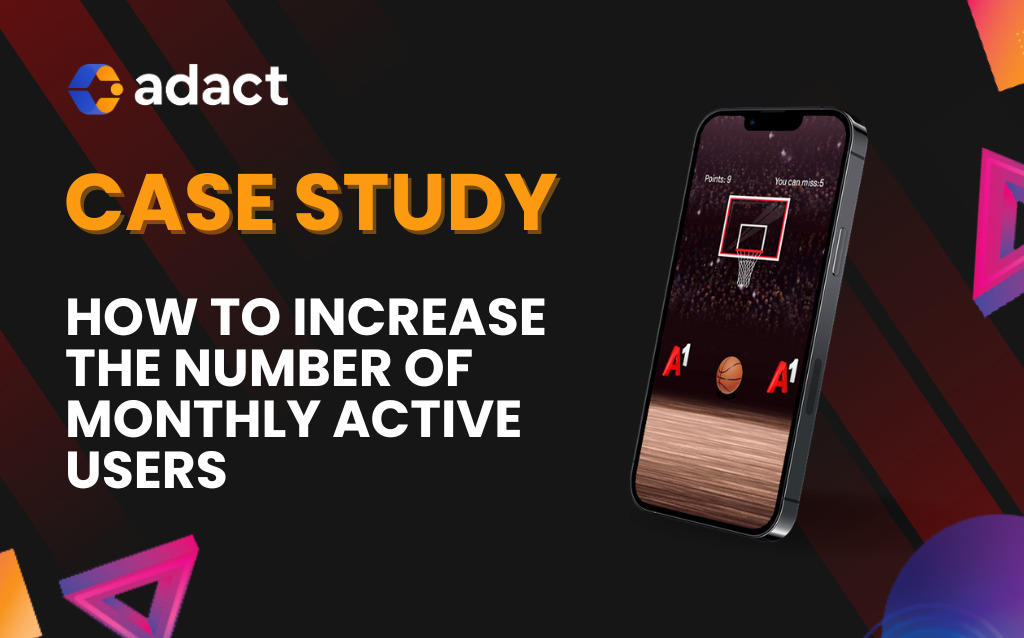
A1 Slovenija, a prominent telecommunications company in Slovenia, decided to embark on an exciting marketing journey during the FIBA World Cup 2023. A1 Slovenija saw an opportunity to connect with their Moj A1 app users in a unique and engaging way.


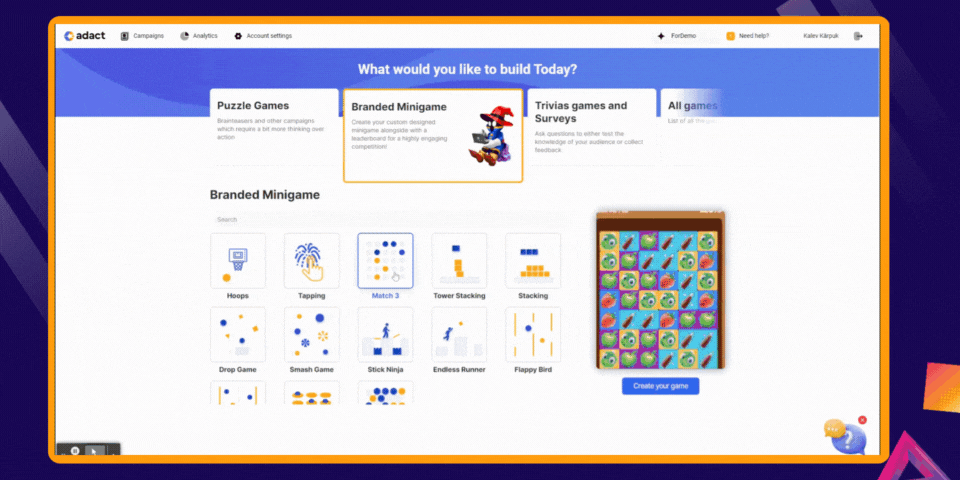
1. Choose the Experience
Choose between 60 unique campaign types. Feel free to create any number of them to brainstorm and see which suits your current goal the best.

2. Make it Your Own
Every experience can be 100% customized to include your branding – Fonts, Colors, Logos, Videos can be changed with ease without writing any code.
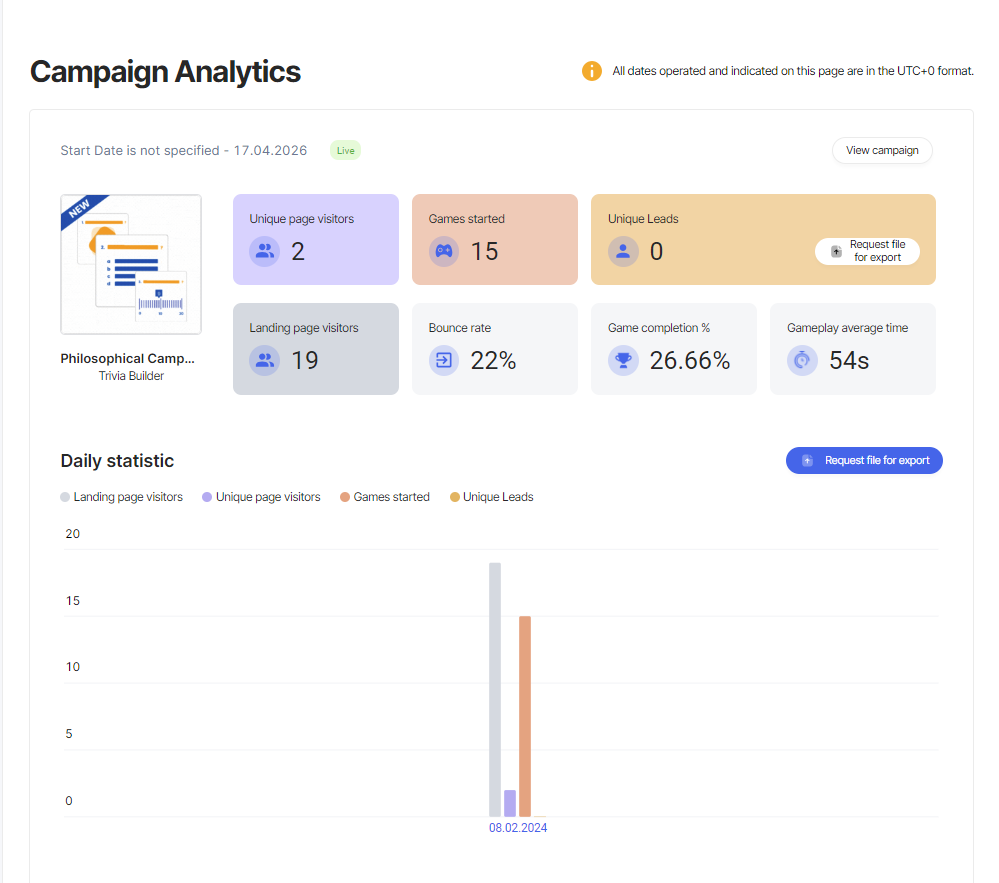
3. Monitor the Results
Get a complete overview of your campaign performance in real-time including Bounce Rates, Conversions and Visitors.
Interactive marketing is a customer-centric approach to promotion that engages audiences through two-way communication and personalized experiences. Unlike traditional marketing methods that rely on one-way messaging, interactive marketing encourages active participation from the audience. This approach often utilizes digital technologies, gamification, and data-driven strategies to create engaging experiences that resonate with individual consumers.
Interactive marketing can take many forms, including:
The goal of interactive marketing is to create a dialogue between brands and consumers, fostering stronger relationships, increasing brand loyalty, and ultimately driving sales through more meaningful and memorable interactions.
Yes, there are numerous free tools and software options available for businesses and marketers looking to implement interactive marketing strategies without a significant upfront investment. Some popular free options include:
Social Media Management Tools:
Analytics Software:
Email Marketing Services:
Content Creation Tools:
Survey and Poll Tools:
Webinar and Live Streaming Platforms:
While these free tools can be excellent starting points, it’s important to note that they often come with limitations in features or capacity. As your interactive marketing efforts grow, you may need to consider paid versions or more advanced tools to meet your expanding needs.
Gamification is a powerful tool in interactive marketing that applies game-design elements and principles to non-game contexts. By incorporating game mechanics into marketing strategies, businesses can increase engagement, motivate desired behaviors, and create memorable experiences for their audience. Here are several ways gamification can be effectively used in interactive marketing:
Loyalty Programs:
Create point-based systems where customers earn rewards for purchases, referrals, or engagement with your brand. For example, Starbucks’ rewards app allows customers to earn stars for purchases, which can be redeemed for free drinks or food items.
Challenges and Competitions:
Organize contests or challenges that encourage user participation and content creation. Nike’s running app challenges users to complete certain distances or beat their personal records, fostering a sense of achievement and community.
Progress Bars and Levels:
Implement visual indicators of progress to encourage users to complete desired actions. LinkedIn uses a profile strength meter to motivate users to add more information to their profiles.
Quizzes and Assessments:
Create interactive quizzes that educate users about your products or services while collecting valuable data. BuzzFeed’s quizzes are a prime example of how engaging content can also serve marketing purposes.
Virtual Currencies or Points:
Implement a system where users can earn and spend virtual currency or points. Duolingo uses this approach to motivate language learners to continue their daily practice.
Leaderboards:
Foster healthy competition among users by displaying top performers. Fitbit uses leaderboards to show step counts among friends, encouraging more physical activity.
Unlockable Content:
Offer exclusive content or features that users can unlock through specific actions or achievements. Dropbox offers additional storage space for completing certain tasks, like referring friends.
Interactive Storytelling:
Create branching narratives where user choices affect the outcome, increasing engagement with your brand story. The Bandersnatch episode of Black Mirror on Netflix is an excellent example of interactive storytelling that engages viewers.
Augmented Reality (AR) Games:
Develop AR experiences that blend the digital and physical worlds. Pokémon GO’s massive success demonstrates the potential of AR in gamified marketing.
Progress-based Rewards:
Offer increasingly valuable rewards as users progress through different levels or stages of engagement with your brand. This encourages long-term loyalty and continued interaction.
When implementing gamification in interactive marketing, it’s crucial to align game elements with your brand’s goals and your audience’s motivations. The key is to create experiences that are both fun and meaningful, driving engagement while also delivering value to your customers and your business.
Absolutely! Interactive marketing principles can be effectively applied to various HR processes, enhancing employee engagement, streamlining operations, and improving overall workplace experiences. Here are several ways interactive marketing techniques can be utilized in HR:
Employee Onboarding:
Create interactive, gamified onboarding programs that introduce new hires to company culture, policies, and procedures in an engaging way. For example, a virtual scavenger hunt could help employees familiarize themselves with different departments and key personnel.
Training and Development:
Implement gamified learning platforms that track progress, award badges for completed courses, and create friendly competition among employees. Platforms like Duolingo for Business use this approach for language learning in corporate settings.
Performance Management:
Develop interactive dashboards that allow employees to track their performance metrics in real-time, set goals, and visualize their progress. This transparency can motivate employees and facilitate more productive performance discussions.
Internal Communications:
Use interactive content like polls, quizzes, and surveys in company newsletters or intranets to increase readership and gather employee feedback. Tools like Microsoft Forms integrated with Teams can facilitate this.
Employee Wellness Programs:
Create challenges and rewards systems for wellness initiatives, encouraging employees to participate in health-related activities. Fitbit’s corporate wellness program is an excellent example of this approach.
Recruitment:
Develop interactive job applications or assessments that give candidates a taste of the company culture and job responsibilities while also evaluating their skills. Pymetrics uses gamified assessments for candidate screening.
Team Building:
Organize virtual team-building activities using interactive platforms. For instance, virtual escape rooms or online multiplayer games can foster collaboration and communication among remote teams.
Employee Recognition:
Implement a points-based recognition system where employees can award each other for good work, with points redeemable for rewards. Platforms like Bonusly facilitate this type of peer-to-peer recognition.
Career Development:
Create interactive career pathing tools that allow employees to explore different roles within the organization and understand the skills and experiences needed for advancement.
Feedback Collection:
Use interactive surveys and pulse checks to regularly gather employee feedback. Tools like Culture Amp offer engaging ways to collect and analyze employee sentiment.
Virtual Meetings and Conferences:
Incorporate interactive elements like live polls, Q&A sessions, and breakout rooms in virtual meetings to increase engagement and participation.
By applying these interactive marketing techniques to HR processes, organizations can create more engaging, efficient, and effective experiences for their employees. This approach can lead to improved employee satisfaction, better retention rates, and a more dynamic and responsive organizational culture.
Creating engaging virtual events requires creativity, planning, and the right mix of interactive elements. Here are some ideas to make your virtual events more engaging and memorable:
Interactive Workshops:
Host hands-on sessions where participants can follow along in real-time. For example, a cooking class where attendees prepare a dish together, or a coding workshop where participants build a simple app.
Live Q&A Sessions:
Incorporate live Q&A sessions with speakers or panelists. Use tools like Slido or Mentimeter to collect and display questions from the audience in real-time.
Virtual Networking Rooms:
Create themed breakout rooms where attendees can network in smaller groups. Use platforms like Wonder or Remo that allow for more natural, spatial audio conversations.
Gamified Scavenger Hunts:
Organize virtual scavenger hunts that encourage attendees to explore different parts of the event platform or complete certain tasks to win prizes.
Personalized Agenda Builders:
Allow attendees to create custom schedules based on their interests, ensuring they don’t miss
sessions that are most relevant to them. This personalization can increase engagement and satisfaction.
Virtual Reality (VR) Experiences:
If feasible, incorporate VR elements into your event. This could be a virtual tour of a product, a 360-degree view of a venue, or even a fully immersive VR conference environment.
Interactive Product Demos:
Instead of traditional presentations, offer live, interactive product demonstrations where attendees can ask questions and see real-time responses.
Live Polling and Surveys:
Regularly engage your audience with live polls and surveys throughout the event. This not only keeps attendees involved but also provides valuable feedback in real-time.
Virtual Photo Booths:
Set up virtual photo booths where attendees can take branded selfies or group photos, which they can then share on social media, increasing event visibility.
Collaborative Whiteboards:
Use tools like Miro or Mural to create collaborative spaces where attendees can brainstorm ideas together in real-time.
Virtual Escape Rooms:
Organize team-building activities like virtual escape rooms that encourage collaboration and problem-solving among attendees.
Live Entertainment:
Include live entertainment segments such as music performances, comedy acts, or magic shows to break up the content and keep energy levels high.
Virtual Exhibition Halls:
Create interactive exhibition spaces where sponsors or vendors can showcase their products or services with 3D models, videos, and live chat options.
Gamified Leaderboards:
Implement a points system for various activities throughout the event (attending sessions, asking questions, networking) and display a leaderboard to encourage participation.
On-Demand Content Libraries:
Offer a mix of live and on-demand content, allowing attendees to access sessions they missed or revisit favorite presentations after the event.
Virtual Wellness Sessions:
Incorporate short wellness breaks like guided meditation, desk yoga, or quick workout sessions to help maintain attendee energy and focus.
Interactive Panel Discussions:
Use tools that allow audience members to upvote questions or contribute to word clouds that guide the discussion topics in panel sessions.
Virtual After-Parties:
Host themed networking events or parties after the main sessions, complete with virtual backgrounds, music, and even drink recipes for attendees to make at home.
Live Social Media Walls:
Display real-time social media posts related to your event hashtag, encouraging attendees to share their experiences and engage with each other’s content.
Personalized AI Chatbots:
Implement AI-powered chatbots that can answer attendee questions, provide personalized recommendations for sessions, and facilitate networking connections.
Remember, the key to a successful virtual event is to make attendees feel actively involved rather than passive observers. By incorporating a mix of these interactive elements, you can create a dynamic and engaging virtual event that leaves a lasting impression on your audience.
Making your virtual conference booth stand out requires creativity, interactivity, and a focus on providing value to attendees. Here are some strategies to help your booth capture attention and engage visitors:
Interactive Product Demos:
Instead of static displays, offer live, interactive demonstrations of your products or services. Use screen sharing, 3D models, or even augmented reality (AR) to give attendees a hands-on experience.
Live Chat Features:
Ensure your booth is staffed with knowledgeable team members who can engage in real-time conversations with visitors. Consider using AI chatbots for initial inquiries to manage high volumes of traffic.
Downloadable Resources:
Offer valuable, downloadable content such as whitepapers, e-books, or exclusive research reports. Make these easily accessible and use them as lead magnets.
Virtual Reality Tours:
If applicable, create a virtual reality tour of your facility, product, or service in action. This immersive experience can leave a lasting impression on visitors.
Gamified Elements:
Incorporate games or challenges related to your brand or industry. For example, a quiz about industry trends with prizes for top scorers, or a virtual scavenger hunt within your booth.
Personalized Experiences:
Use data collected during registration to personalize the booth experience for each visitor. This could include customized greetings, tailored product recommendations, or industry-specific information.
Live Presentations or Mini-Webinars:
Schedule short, live presentations
or mini-webinars at regular intervals. These can be on topics related to your products, industry trends, or case studies. Ensure these are interactive, allowing for Q&A sessions.
Virtual Photo Booth:
Set up a branded virtual photo booth where visitors can take fun, shareable photos. This can increase engagement and boost your brand’s visibility on social media.
One-on-One Meeting Scheduler:
Implement a system where attendees can easily schedule one-on-one meetings with your team members for more in-depth discussions or personalized demos.
Interactive Product Configurator:
If applicable, offer an interactive tool where visitors can customize your product or service to their needs, providing a tangible sense of what you offer.
Live Social Media Feed:
Display a live feed of social media posts related to your booth or brand, encouraging visitors to engage and share their experiences.
Virtual Goodie Bags:
Offer digital “swag bags” with exclusive discounts, free trials, or digital gifts that provide value to attendees.
Themed Environment:
Create a visually striking and themed virtual environment that aligns with your brand and stands out from other booths. This could include interactive elements that visitors can explore.
Leaderboard Challenges:
Implement challenges or quizzes related to your industry or products, with a live leaderboard displaying top performers. Offer prizes for the winners to encourage participation.
Interactive Infographics:
Present key information about your products or services through interactive infographics that visitors can explore at their own pace.
Virtual Reality Networking Spaces:
If the platform allows, create a VR networking space within your booth where visitors can interact with each other and your team in a more immersive environment.
Live Polls and Surveys:
Conduct live polls or surveys related to industry trends or challenges. Share the results in real-time, creating a sense of community and providing valuable insights to attendees.
Exclusive Content Reveals:
Use your virtual booth to reveal exclusive content, such as new product announcements or industry reports, creating a sense of excitement and urgency for visitors.
Interactive FAQ Section:
Create an engaging, interactive FAQ section where visitors can find answers to common questions through a user-friendly interface, possibly using a chatbot or decision tree format.
Virtual Assistant Guide:
Implement a virtual assistant or animated character that guides visitors through your booth, highlighting key features and providing a more personalized experience.
Integration with Physical Elements:
If it’s a hybrid event, consider ways to integrate physical elements with your virtual booth. For example, QR codes at a physical location that unlock special features in the virtual booth.
Follow-up Automation:
Set up an automated system to follow up with booth visitors, providing additional resources or scheduling further conversations based on their interactions in your virtual booth.
Remember, the key to a successful virtual booth is not just about flashy technology, but about creating meaningful interactions and providing real value to attendees. Focus on understanding your audience’s needs and tailoring your booth experience to meet those needs in an engaging and memorable way.
Successful interactive marketing campaigns have the power to engage audiences, create buzz, and drive significant results for brands. Here are some notable examples:
Nike’s “Nike By You” (formerly Nike ID):
This long-running campaign allows customers to design and personalize their own Nike shoes online. It’s a prime example of co-creation, where customers become part of the product design process.
Coca-Cola’s “Share a Coke” Campaign:
Coca-Cola replaced its logo on bottles with popular names, encouraging people to find bottles with their names or friends’ names. This personalization strategy led to increased sales and social media engagement.
Burger King’s “Whopper Detour” App-Based Promotion:
This geo-fenced campaign offered customers a Whopper for just 1 cent if they used the Burger King app within 600 feet of a McDonald’s location. It drove app downloads and store visits.
Domino’s Pizza Tracker:
This interactive tool allows customers to track their pizza from order to delivery in real-time, increasing engagement and transparency in the ordering process.
Old Spice’s “The Man Your Man Could Smell Like” Interactive Videos:
This campaign allowed viewers to interact with the Old Spice Guy through a series of personalized video messages, creating a viral sensation.
Airbnb’s “Night At” Campaign:
Airbnb offers unique overnight stays in unexpected locations (like the Louvre or Dracula’s Castle), generating buzz and highlighting the uniqueness of their accommodation options.
Snapchat’s Augmented Reality Lenses:
While not a single campaign, Snapchat’s AR lenses have been used by numerous brands to create interactive, shareable experiences.
Ally Bank’s “Lucky Penny” Campaign:
Ally hid 100 “lucky pennies” in 10 U.S. cities, each worth $1,000. This scavenger hunt-style campaign generated significant media coverage and social media engagement.
Heineken’s “Go Places” Interactive Interview:
This campaign used an interactive video interview to engage potential job applicants, showcasing the company culture in an innovative way.
Chipotle’s “A Love Story” Game:
Chipotle created a mobile game that educated players about the company’s commitment to fresh ingredients while offering rewards for real-world purchases.
IKEA’s Augmented Reality Catalogue:
IKEA’s AR app allows customers to virtually place furniture in their homes before purchasing, blending digital interaction with practical shopping needs.
M&M’s “Eye Spy Pretzel” Campaign:
This campaign asked Facebook users to spot a tiny pretzel hidden among M&M’s in an image, engaging millions of users in a simple yet addictive challenge.
Porsche’s “The Holodeck”:
Porsche created a VR experience allowing customers to configure and experience their dream car in a virtual environment.
Lay’s “Do Us A Flavor” Contest:
This recurring campaign invites customers to submit and vote on new potato chip flavors, engaging consumers in product development.
Starbucks’ Holiday Cup AR:
Starbucks used augmented reality to bring their holiday cups to life, encouraging customers to interact with their products through their mobile devices.
These campaigns showcase various interactive marketing strategies, from personalization and gamification to augmented reality and user-generated content. The success of these campaigns often lies in their ability to create engaging, shareable experiences that resonate with the target audience while aligning with the brand’s values and objectives.
Interactive marketing can significantly improve sales by creating more engaging, personalized, and memorable experiences for customers. Here’s how it contributes to increased sales:
Enhanced Customer Engagement:
Interactive marketing encourages active participation from customers, leading to higher engagement levels. Engaged customers are more likely to make purchases and become loyal to the brand.
Personalized Experiences:
By collecting data through interactive elements, marketers can create highly personalized experiences. This tailored approach can increase relevance and appeal to individual customers, boosting conversion rates.
Improved Customer Understanding:
Interactive marketing provides valuable insights into customer preferences and behaviors. This data can be used to refine products, services, and marketing strategies, ultimately leading to better sales performance.
Increased Brand Awareness and Recall:
Interactive campaigns often create memorable experiences that stick with consumers. This improved brand recall can lead to increased consideration and purchases when customers are ready to buy.
Building Trust and Relationships:
By fostering two-way communication, interactive marketing helps build trust and stronger relationships with customers. This can lead to increased customer loyalty and repeat purchases.
Real-Time Feedback and Adaptation:
Interactive elements allow for immediate feedback from customers, enabling businesses to quickly adapt their offerings or marketing approach, potentially salvaging sales that might otherwise be lost.
Gamification and Incentives:
Interactive marketing often incorporates gamification elements that can incentivize purchases. For example, loyalty programs with points or rewards can encourage repeat business.
Increased Time Spent with Brand:
Interactive content typically keeps users engaged for longer periods, increasing the chances of conversion and allowing more time for the brand message to sink in.
Viral Potential:
Engaging interactive campaigns have a higher likelihood of being shared on social media, potentially reaching a wider audience and generating more leads and sales opportunities.
Improved Product Understanding:
Interactive product demonstrations or configurators can help customers better understand the value and features of products, reducing hesitation and increasing the likelihood of purchase.
Streamlined Purchase Process:
Interactive elements can guide customers through the buying journey more effectively, reducing friction and making it easier for them to complete purchases.
Cross-Selling and Upselling Opportunities:
Interactive marketing can intelligently suggest complementary products or upgrades based on customer interactions, increasing average order value.
Enhanced Customer Support:
Interactive FAQs, chatbots, and other support tools can quickly address customer concerns, removing barriers to purchase.
Creating Urgency:
Interactive countdown timers or limited-time offers can create a sense of urgency, prompting quicker purchase decisions.
Improved Ad Targeting:
Data collected through interactive marketing can be used to create more effective ad targeting, ensuring marketing spend is focused on the most promising prospects.
Customer-Centric Product Development:
Interactive campaigns that involve customers in product development or feature selection can lead to products that better meet market demands, potentially driving higher sales.
Emotional Connection:
Interactive experiences can create stronger emotional connections with a brand, which can be a powerful driver of purchase decisions.
Reduced Perceived Risk:
Interactive product trials or virtual try-ons can help customers feel more confident in their purchase decisions, reducing the perceived risk of buying.
Increased Customer Lifetime Value:
By creating more engaging and satisfying customer experiences, interactive marketing can increase customer lifetime value through repeat purchases and brand loyalty.
Competitive Differentiation:
Innovative interactive marketing can set a brand apart from competitors, potentially capturing market share and driving sales growth.
By leveraging these aspects of interactive marketing, businesses can create a more engaging, personalized, and effective sales process. This approach not only drives immediate sales but also builds long-term customer relationships that can lead to sustained revenue growth over time. The key is to implement interactive elements strategically, always keeping the customer’s needs and preferences at the forefront of the marketing strategy.
There are numerous tools available for creating interactive virtual meetings, each offering unique features to enhance engagement and collaboration. Here’s an overview of some popular options:
Zoom:
Microsoft Teams:
Google Meet:
Cisco Webex:
GoToMeeting:
Slido:
Mentimeter:
engaging presentations and gathering real-time feedback
Miro:
Mural:
Wonder:
Remo:
Hopin:
Adobe Connect:
BlueJeans:
Kahoot!:
Padlet:
Pigeonhole Live:
Spatial:
Butter:
Icebreaker:
When choosing a tool for interactive virtual meetings, consider factors such as:
It’s often beneficial to try out a few different tools to see which ones work best for your specific needs and audience. Many of these platforms offer free trials or basic free versions, allowing you to test their features before committing to a paid plan.
Remember that the success of an interactive virtual meeting depends not just on the tool used, but also on how well the host leverages its features to create an engaging experience. It’s important to familiarize yourself with the chosen platform and plan your meeting structure to make the most of its interactive capabilities.
Measuring the success of interactive marketing efforts is crucial for understanding the effectiveness of your campaigns and making data-driven decisions for future strategies. Here are several key metrics and methods to evaluate the success of your interactive marketing initiatives:
Engagement Rates:
Conversion Rates:
Lead Generation:
User-Generated Content:
Social Shares and Virality:
Time Spent Interacting:
non-interactive content to gauge the effectiveness of your interactive approach.
7. Return on Investment (ROI):
– Calculate the financial return generated by your interactive marketing campaigns relative to their cost.
– Consider both direct revenue and long-term customer value.
8. Brand Awareness and Recall:
– Conduct surveys to measure changes in brand awareness before and after interactive campaigns.
– Use brand recall tests to assess how memorable your interactive experiences are.
9. Customer Feedback and Sentiment:
– Collect and analyze customer feedback on your interactive marketing initiatives.
– Use sentiment analysis tools to gauge overall reception of your campaigns.
10. Repeat Engagement:
– Track how often users return to interact with your content or platforms.
– Measure the frequency of repeat purchases or interactions from engaged customers.
11. App or Website Analytics:
– Monitor metrics like daily active users, session length, and user flow through your interactive experiences.
– Analyze bounce rates and exit pages to identify potential areas for improvement.
12. A/B Testing Results:
– Compare the performance of different versions of your interactive content to optimize effectiveness.
– Analyze which interactive elements drive the best results.
13. Email Marketing Metrics:
– If your interactive marketing includes email campaigns, track open rates, click-through rates, and conversion rates.
14. Customer Lifetime Value (CLV):
– Assess whether interactive marketing efforts are increasing the long-term value of your customers.
15. Net Promoter Score (NPS):
– Use NPS surveys to measure customer loyalty and likelihood to recommend your brand after engaging with interactive content.
16. Sales Metrics:
– Track changes in sales volume, average order value, and customer acquisition costs that can be attributed to interactive marketing efforts.
17. Audience Growth:
– Measure increases in followers, subscribers, or community members resulting from interactive campaigns.
18. Competitive Benchmarking:
– Compare your interactive marketing performance against industry standards and competitors.
19. Qualitative Feedback:
– Gather insights from customer interviews, focus groups, or open-ended survey questions about their experience with your interactive marketing.
20. Cross-Channel Impact:
– Assess how interactive marketing efforts on one channel affect performance on others (e.g., how a social media campaign impacts website traffic).
21. Cost Per Acquisition (CPA):
– Calculate the cost of acquiring a new customer through interactive marketing compared to other methods.
22. Customer Segmentation Effectiveness:
– Evaluate how well your interactive marketing performs across different customer segments.
To effectively measure these metrics:
1. Set Clear Objectives: Define what success looks like for each interactive marketing campaign before launching.
2. Use Analytics Tools: Implement robust analytics platforms (e.g., Google Analytics, social media analytics tools) to track performance.
3. Create Custom Dashboards: Develop dashboards that display your most important KPIs for easy monitoring and reporting.
4. Regular Reporting: Establish a routine for reviewing and reporting on these metrics to stakeholders.
5. Continuous Improvement: Use insights gained from these measurements to continuously refine and improve your interactive marketing strategies.
6. Attribution Modeling: Implement attribution models to understand how different touchpoints in your interactive marketing contribute to conversions.
7. Integrate Data Sources: Combine data from various sources to get a holistic view of your interactive marketing performance.
Remember that the most relevant metrics will depend on your specific goals, industry, and the nature of your interactive marketing campaigns. It’s important to focus on the metrics that align most closely with your overall business objectives and provide actionable insights for improving your marketing efforts.


Let’s Work Together & Grow Your Business
Call Now -
1-800-700-600
Location -
Plan Your Visit -
Social Media -



Feeling overwhelmed by the countless interactive marketing tools available? Get expert guidance and tailored suggestions to help you choose the ideal interactive marketing solution that will captivate your audience and skyrocket your conversions.